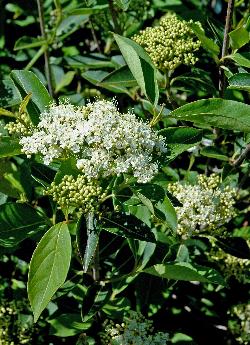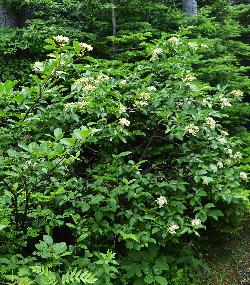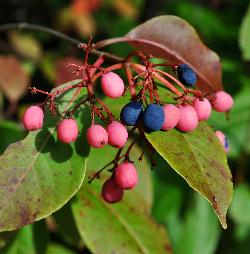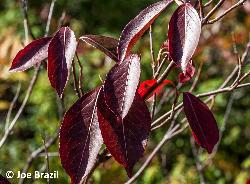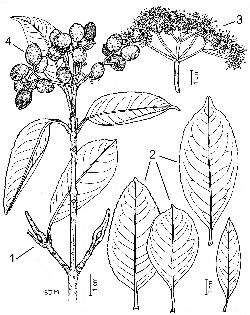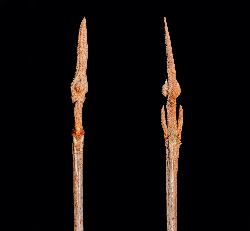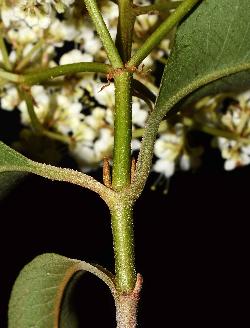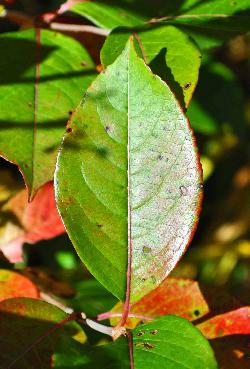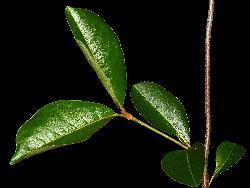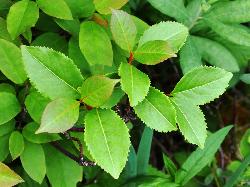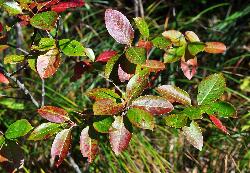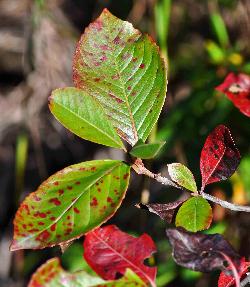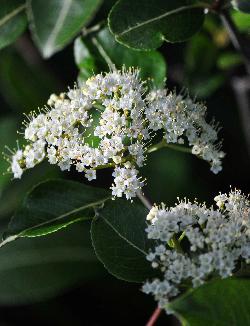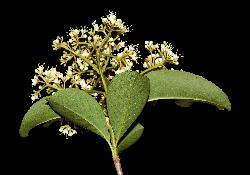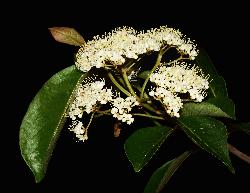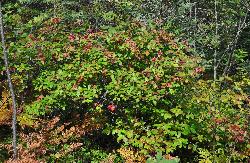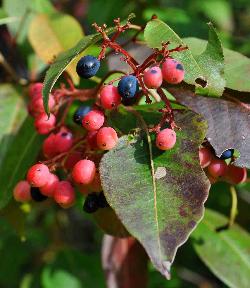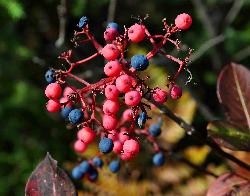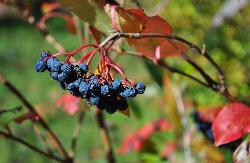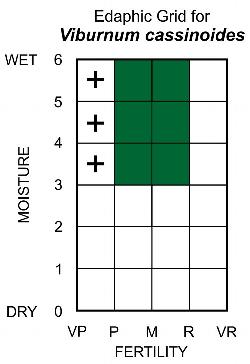Fr: viorne cassinoïde, bleuets sains, alisier
Viburnaceae - Viburnum Family
Note: Numbers provided in square brackets in the text refer to the image presented above; image numbers are displayed to the lower left of each image.
General: An upright medium-sized deciduous shrub, 1–3 m tall. Northern wild raisin makes an excellent addition to a native plant garden, offering large showy flowers in early to mid-summer [1–2], colourful fruit that attract birds in late summer [3], and attractive foliage, dark glossy green in summer and bright orange to red in fall [4].
Key Features: (numbers refer to the illustration [5])
- Twigs have long slender flexible rusty-brown buds with 2 valvate somewhat leaf-like scales; terminal flower buds have 2 elongate scales encircling the bud of the inflorescence.
- Leaves are opposite, simple, often glossy above, leathery (coriaceous) in texture, and variable in shape, with entire or coarsely toothed (dentate or serrate) margins.
- Inflorescences are broad with numerous flowers, all fertile and similar in size; stamens extend beyond the corolla (stamens exserted).
- Immature fruit (drupes) are pale green to pink, while mature fruit are blue and wrinkled.
Stems/twigs: The terminal and lateral vegetative buds are opposite, narrowly oblong to linear, very flexible, and scurfy (rough-textured). The buds are essentially naked buds, with typical bud scales replaced by two long narrow modified leaf-like scales covered with tiny rusty-brown peltate scales that provide the buds with its scurfy texture [6]. As the buds open, the 2 valvate scales expand into typical leaves, rather than fall off once the buds open. Twigs are slender with light greyish-brown mostly glabrous bark, although young twigs may be scurfy near the terminal buds. Flower buds are terminal, with 1 pair of flexible scales encircling the shorter and wider inflorescence bud [6].
Leaves: Opposite, simple, pinnately-veined, and firm to leathery (coriaceous) in texture; petioles are 0.5–2 cm long, grooved, and sometimes slightly winged [7–8]. Leaf blades are 2.5–15 cm long by 1.5–6 cm wide, glabrous, dark green, and lustrous above (sometimes with a dull bloom); the lower surface is slightly paler. Northern wild raisin leaves are quite variable in shape; usually they are elliptic or oblanceolate [9–10], but range from narrowly lanceolate to obovate. Leaf bases are tapering (cuneate) to rounded, leaf apices are blunt (obtuse), pointed (acute), or taper abruptly to a narrow blunt tip; margins are entire, wavy, dentate, or coarsely serrate [9–12]. Immature leaves may be sharply serrate, but the teeth become indistinct as the leaf expands. Leaves turn orange to red or reddish-purple in autumn [13–14].
Flowers: Bisexual; the numerous small white flowers are arranged in large flat-topped branched terminal inflorescences (compound cymes), 3–10 cm across [15–17]. All flowers of the inflorescence are fertile, of approximately the same size, and have a slightly disagreeable odour. Individual flowers have a short inconspicuous green calyx with 5 lobes and a short campanulate 5-lobed white corolla [18]; the 5 stamens are attached to and exserted 1–3.5 mm beyond the corolla [19–20]; the single pistil has an inferior ovary. Flowers bloom in early summer; pollination is by a variety of different insects (entomophily) (Donoghue 1980).
Fruit: A cluster of ellipsoid to ovoid, berry-like drupes, each 6–9 mm long, with a single seed enclosed in a flat stony pit. Young fruit are greenish-white, soon turning bright pink, then maturing in mid to late summer to bluish-black [21–24]. The skin changes from smooth to wrinkled at maturity, often with a heavy bluish-grey glaucous bloom [25]. Fruit are edible, with sweet pulp, and ripen in mid to late summer. In late autumn, the decaying leaves and fallen fruit give off a distinctive sweetish odour.
Ecology and Habitat: Northern wild raisin is a distinctly southern species in Newfoundland and Labrador, rarely found on the Northern Peninsula and absent from Labrador. It is most common on nutrient-poor, moist to wet sites, but can occur sporadically on rich sites. It is most abundant in naturally open woodland sites. It can spread rapidly through root sprouting on burns and cutovers.
Edaphic Grid: See image [26]: the Edaphic Grid for Viburnum cassinoides.
Forest Types: Northern wild raisin occurs is most abundance in the following forest types:
- Kalmio-Piceetum typicum (Kalmia-Black Spruce Forest Subassociation)
- Osmundo-Piceetum (Osmunda-Black Spruce Fen Association)
- Sphagno-Piceetum nemopanthetosum (Sphagnum-Nemopanthus-Black Spruce Bog Subassociation)
Northern wild raisin is distinctly more common and vigorous in the Maritime Barrens and Avalon Ecoregions (Damman 1983). It can also be found sporadically in low abundance in a wide range of closed forest types, where it is often stunted and exhibits a wide range of leaf shapes.
Succession: Northern wild raisin can survive in a wide range of forest stands, often persisting as a depauperate form under shaded conditions. However, following clearcutting or fire, it rapidly recovers through root sprouts and forms a medium to large shrub that can reach 15–25% cover in seral vegetation 10–20 years post-disturbance.
Distribution: In Insular Newfoundland, northern wild raisin occurs from the Avalon Peninsula to western Newfoundland, although it is most common on the south and east coasts. In western Newfoundland, it extends into Gros Morne Park, but does not occur on central and northern portions of the Great Northern Peninsula. Northern wild raisin is absent from Labrador. In mainland Canada, it occurs in the Maritime Provinces, southern Quebec and Ontario, north to Lake Abitibi (about 48° 50' N) and west to the Algoma District (Scoggan 1978, Soper and Heimburger 1982). In the United States, it occurs through New England and the Lake States, west to Wisconsin, and south to Alabama (USDA, NRCS. 2016).
Similar Species: There are two other native Viburnum species in Newfoundland, squashberry (Viburnum edule (Michx.) Raf.) and highbush cranberry (Viburnum trilobum Marshall). Both species are easily differentiated from northern wild raisin by their 3-lobed leaves and red fruit. Squashberry has inflorescences with fertile flowers all the same size, while highbush cranberry has a marginal row of sterile flowers with flat 5-lobed corollas that surround numerous small fertile flowers at the centre of the inflorescence.


